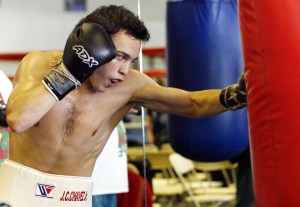
SAN ANTONIO – Tuesday, three or so hours after Julio Cesar Chavez Jr. skipped an open workout at Jesse James Leija’s gym, a workout that might have given local insiders a more favorable view of him, a remarkable new exhibition opened at The McNay – the crown jewel of South Texas art museums. “Andy Warhol: Fame and Misfortune,” a collection that includes 150 of Warhol’s works, examines the fascination we have with celebrities, especially when tragedies befall them.
Several days later, more than a few of the more than 14,000 South Texans who gathered in Alamodome to see Chavez fight fellow Mexican Marco Antonio Rubio no doubt looked forward to a tragedy befalling a celebrity in the main event.
Alas, they were disappointed once more. Chavez, confronting for the first time since 2007 another Mexican national, went chest-to-chest, head-to-head and elbow-to-shoulder with Rubio for at least 30 of their 36 minutes together and beat the smaller man convincingly, or at least unanimously.
Ringside judges had the match for Chavez by scores of 115-113, 116-112 and 118-110. Scoring from ringside, my card, too, went for Chavez, 116-114. That’s not a typo. I scored the first two rounds even, 10-10, before scoring rounds 3, 5, 6, 8, 10 and 11 for Chavez, and the rest for Rubio. I scored the first two rounds even because it seems a scorer’s job is not to strain to divine a winner in each round but rather allow the combatants to strain for his favor.
Why juxtapose Culiacan’s Chavez and Pittsburgh’s Warhol, when aside from a temporary accident of geography, the two men have nothing in common? Because fame, a thing that happened naturally for the less talented – though not that much less talented – Chavez was a point of endless pursuit and fascination for the late Warhol who is, and will remain, more influential in the world than Chavez or the father whose name he won at birth.
A note about that name. At the kick-off press conference in January, Chavez was more animated than usual. Rubio and Sergio Martinez had been calling for fights with him, using, of course, the none too subtle implication Chavez was as protected in his prizefighting career as in his early life. The WBC’s Jose Sulaiman had recently risen from his wheelchair to wrest the belt from Martinez’s person and give it to Chavez – giving the Argentine middleweight champion a fair claim on some future match with Chavez.
“They want to make money with my name and my fame,” Chavez responded in Spanish, without even a theatrical touch of irony. “Of course I am frustrated.”
Wait, whose name and fame?
That question is a poser for Warhol’s philosophy, as it turns out. Warhol saw fame and achievement and commercial success, all, as one in the same thing. He raised cupidity to an art form, mass producing screen prints in a workshop and publicly measuring their value by the strictest monetary means. He reduced aesthetics to economics, and in so doing showed Americans, those curious children of the world’s most ambitious salesmen, a pastel-coated reflection of themselves. And instead of being revolted, we very much liked it.
Warhol endures today in large part because he was a first mover – to employ a marketism that should revolt any art critic. Warhol anticipated everything from the logo on the t-shirt you wore this weekend, to HBO’s “24/7” program and the celebrity it has made of Money May, a character who, in his desperation and grasping, likely would have enchanted Warhol. But Warhol also had an Eastern Orthodox sense of justice (incidentally, he was quite religious).
He wanted fame to be earned in some way. Which is where the Chavez case makes things interesting. Famous in his country from about the time he began grade school, Chavez never wanted for notice or celebrity. When he made his pro debut, without so much as an amateur tune-up, it was nationally televised in Mexico – the sort of acclaim Americans no longer accord even Olympic gold medalists, if ever we have another of those.
Chavez was famous solely for another man’s toils, and one might infer such an outcome would not have enchanted Warhol.
But what about today’s Chavez, the man who shoved and whacked Marco Antonio Rubio round the ring, Saturday? That’s a more interesting question. This Chavez, still resentful of underclass usurpers, still prone to the majestic rights of doing whatever the hell he pleases – showing up 30 pounds overweight for training camp and then adhering to the spartan ritual of driving the streets of Los Angeles allegedly drunk at 4:30 on a Sunday morning – this Chavez, as a self-inventing celebrity of his own, is another thing entirely.
He has something for each observer to loathe and admire at once; anyone who still thinks Chavez is all good or all bad is employing a filter too many.
Chavez can fight a little bit, can’t he? Rubio was probably just past his expiration date, as predicted, but power is the last thing to go, as the old timers say, and Chavez absorbed plenty Rubio right hands. Lefts, too. What did Chavez do? He moved closer to his aggressor, wading into the beating rain of Rubio’s fists till he found a quieter, softer place. Exactly as you’re supposed to do. Who would have thought that five fights into a collaborative experiment with trainer Freddie Roach – and weightloss guru Alex Ariza – Chavez Jr. would be fighting so much more like Chavez Sr.?
Misfortune will befall Chavez eventually; it befalls everyone who makes his living in this brutal, gorgeous game. Chavez will be stretched prone across the canvas by someone in the next 10 years, finally making of himself an apt subject for a Warhol canvas.
Chavez, as a subject, grows more interesting with each fight.
Bart Barry can be reached at bart.barrys.email (at) gmail.com










